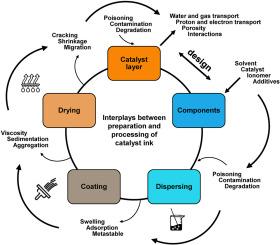Interplays between preparation and processing of the catalyst ink in the manufacturing of a proton exchange membrane fuel cell catalyst layer
IF 7.9
2区 工程技术
Q1 CHEMISTRY, PHYSICAL
引用次数: 0
Abstract
Catalyst inks are essential for the fabrication of Catalyst Layers (CLs) in Proton Exchange Membrane Fuel Cell (PEMFC) electrodes. While the fabrication process appears straightforward and numerous innovations have emerged in both research and industry, a comprehensive and openly accessible framework for rational ink formulation and CL fabrication is still developing. This gap is largely due to limited public insight into the links between ink and CL properties, structure, and performance, as much industrial know-how remains proprietary. This paper first examines the preparation of catalyst inks—primarily composed of an ionomer, catalyst, solvent, and sometimes additives such as antioxidants—highlighting recent advances in understanding their properties, interactions and influence on ink behaviour and processability. The discussion then turns to ink coating techniques, such as spraying and printing, and explores how these methods impact the structural, mechanical, and chemical characteristics of the resulting CL. Drying processes are also considered, with attention to how different approaches affect final CL properties. By analysing the interplay between ink formulation, coating, and drying, this work sheds light on the feedback-driven, iterative dynamics that underpin CL fabrication in PEMFCs, aiming to guide more rational and effective design strategies.

质子交换膜燃料电池催化剂层制造中催化剂油墨制备与加工之间的相互作用
催化剂油墨是质子交换膜燃料电池(PEMFC)电极中催化剂层(CLs)的重要组成部分。虽然制造过程看起来很简单,并且在研究和工业中都出现了许多创新,但合理的油墨配方和CL制造的全面和开放的框架仍在发展中。这种差距很大程度上是由于公众对油墨和CL属性、结构和性能之间的联系的了解有限,因为许多工业知识仍然是专有的。本文首先考察了催化剂油墨的制备——主要由离聚物、催化剂、溶剂和有时还有抗氧化剂等添加剂组成——重点介绍了在了解它们的性质、相互作用以及对油墨行为和可加工性的影响方面的最新进展。然后讨论油墨涂层技术,如喷涂和印刷,并探讨这些方法如何影响所得到的CL的结构,机械和化学特性。还考虑了干燥过程,注意不同的方法如何影响最终CL性质。通过分析油墨配方、涂层和干燥之间的相互作用,本研究揭示了支撑pemfc中CL制造的反馈驱动、迭代动力学,旨在指导更合理、更有效的设计策略。
本文章由计算机程序翻译,如有差异,请以英文原文为准。
求助全文
约1分钟内获得全文
求助全文
来源期刊

Journal of Power Sources
工程技术-电化学
CiteScore
16.40
自引率
6.50%
发文量
1249
审稿时长
36 days
期刊介绍:
The Journal of Power Sources is a publication catering to researchers and technologists interested in various aspects of the science, technology, and applications of electrochemical power sources. It covers original research and reviews on primary and secondary batteries, fuel cells, supercapacitors, and photo-electrochemical cells.
Topics considered include the research, development and applications of nanomaterials and novel componentry for these devices. Examples of applications of these electrochemical power sources include:
• Portable electronics
• Electric and Hybrid Electric Vehicles
• Uninterruptible Power Supply (UPS) systems
• Storage of renewable energy
• Satellites and deep space probes
• Boats and ships, drones and aircrafts
• Wearable energy storage systems
 求助内容:
求助内容: 应助结果提醒方式:
应助结果提醒方式:


